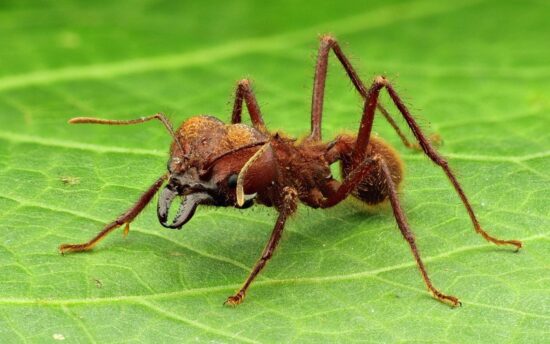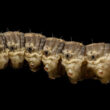Leaf cutter ants can turn your beautiful garden into a barren wasteland overnight. These tiny farmers are some of the most destructive pests in the southern United States, especially in Texas, Louisiana, and parts of Arizona and California. Unlike regular ants that you might find raiding your kitchen, leaf cutter ants don’t eat the leaves they cut. Instead, they use them to grow fungus underground, which becomes their food source.
This unique behavior makes getting rid of leaf cutter ants much harder than dealing with other ant species. Traditional ant baits filled with sugar or grease won’t work because these ants only eat the fungus they cultivate. That’s why you need special strategies designed specifically for these agricultural pests.
The good news? There are proven methods that work. This guide covers some effective ways to get rid of leaf cutter ants, from simple home solutions to professional treatments. Whether you’re protecting a single rose bush or managing a large property, you’ll find the right approach here.
1. Apply Hydramethylnon Baits (Amdro Ant Block)
When it comes to getting rid of leaf cutter ants with store-bought products, hydramethylnon baits are your best bet. Texas A&M University and AgriLife Extension scientists recommend this ingredient as the only effective bait option for homeowners dealing with leaf cutter ants.
The most common product containing hydramethylnon is Amdro Ant Block. You can also find it in Extinguish Plus. These baits work because they contain added sugars that attract leaf cutter ants, even though they don’t normally eat sweet foods. The ants carry the poisoned bait back to their colony, where it eventually reaches the fungus gardens and kills the entire nest.
How to use hydramethylnon baits:
- Apply the bait during active foraging periods (usually at night)
- Sprinkle it around the central nest area, not just individual mounds
- Use a mechanical spreader for large areas or apply by hand while wearing gloves
- Wait 5 to 7 days before expecting to see reduced ant activity
These baits eliminate colonies about 30% of the time with a single application. Most situations require repeat treatments to completely get rid of the ants. The bait has a short shelf life of only three months, so don’t buy more than you can use quickly.
Important limitations: You cannot use these products in areas where you grow food crops, around livestock pastures, or in vegetable gardens. Always read the label carefully before applying.
2. Drench Mounds with Non-Repellent Insecticides
Non-repellent insecticides like Dominion 2L work exceptionally well for getting rid of leaf cutter ants because the ants can’t detect the chemicals. This means they walk through treated areas and carry the poison back to their colony without knowing it.
The key to success with this method is finding and treating every single mound. Leaf cutter colonies can have hundreds of entrance holes spread across large areas, so thorough inspection is critical. Missing even a few mounds can allow the colony to survive and rebuild.
Application steps:
- Mix 1 ounce of Dominion 2L with 5 gallons of water for mound drenching
- Use 3/4 ounce per gallon when treating foraging trails
- Apply the mixture directly into mound entrances using a pin stream setting
- Treat the central nest area and all satellite mounds you can find
Start by walking your entire property to map out all the ant mounds. Look for the distinctive crater-shaped soil piles and worn trails between mounds. Early morning or late evening are the best times to spot active mounds.
The systemic action of non-repellent insecticides means the poison spreads throughout the entire colony as ants interact with each other. This makes it one of the most effective methods to get rid of leaf cutter ants when applied correctly.
3. Use Professional Treatments (PTM Injections and Thermal Fogging)
For severe infestations or valuable crops, professional treatments provide the highest success rates. These methods require specialized equipment and training, but they can eliminate entire colonies with a single application.
PTM Fipronil Injections are considered the gold standard for leaf cutter ant control. Professional technicians inject PTM directly into every mound entrance hole. This treatment has an impressive 88% success rate for completely eliminating colonies after just one application. The injection method ensures the active ingredient reaches deep into the colony where the fungus gardens are located.
Thermal Fogging works by saturating the entire underground colony with insecticidal smoke. Technicians use specialized equipment to pump toxic smoke through the colony’s natural ventilation system. The smoke fills every chamber and tunnel, providing immediate control of even the largest colonies.
Both methods require certified pest control professionals because of the specialized equipment needed and potential environmental risks. While these treatments cost more than DIY options, they’re often worth the investment for severe infestations or when protecting high-value crops.
Professional treatments work best on established colonies with multiple mounds. If you’re dealing with a single small mound, other methods might be more cost-effective.
4. Create Physical Barriers with Cotton Fiber
One of the most effective natural ways of getting rid of leaf cutter ants involves using their own anatomy against them. The hook-shaped claws on ant feet make it extremely difficult for them to cross fibrous materials like cotton. When ants encounter cotton barriers, they slow down so much that they usually give up and look elsewhere for food.
This method works because leaf cutter colonies depend on speed and efficiency. If collecting leaves becomes too difficult or time-consuming, the ants will abandon the food source and move to easier targets.
How to install cotton barriers:
- Wrap cotton fiber bands around tree trunks and plant stems about 6 inches above ground
- Keep the cotton from touching the soil to prevent ants from finding ways around it
- Use natural fibers like raw cotton or silk floss tree fibers
- Replace the cotton when it starts to break down, especially after heavy rains
You can find raw cotton fiber at craft stores or online. Some gardeners also use the fluffy seed fibers from silk floss trees (Ceiba species) if they’re available in your area.
Cotton barriers work best when combined with mulch around the base of plants. The combination creates multiple obstacles that make your plants much less attractive to foraging ants.
5. Apply Neem Oil as Plant Protection
Neem oil contains a natural compound called azadirachtin that makes treated leaves taste terrible to leaf cutter ants. Even better, when ants do manage to cut neem-treated leaves, the oil disrupts their fungus cultivation process. This makes neem oil an excellent tool for getting rid of leaf cutter ants naturally.
You can apply neem oil in several ways depending on your needs. Foliar spraying protects plants immediately but requires frequent reapplication. Soil drenching takes longer to work but provides systemic protection that lasts longer.
Application methods:
- Foliar spray: Mix neem oil with water according to label directions and spray directly on leaves
- Soil drench: Pour diluted neem oil around the root zone so plants absorb it through their roots
- Trail treatment: Apply neem oil directly to ant foraging trails
The most interesting thing about neem trees is that young trees get attacked by leaf cutter ants, but mature neem trees become naturally resistant. This suggests that older neem trees produce higher concentrations of protective compounds.
Plan to reapply neem oil frequently, especially after rain. The natural compounds break down quickly in sunlight and wash away easily. For best results, apply neem oil in the evening when ants are most active and beneficial insects like bees are less likely to encounter it.
6. Install Smooth Plastic Barriers
Leaf cutter ants are surprisingly poor climbers when it comes to smooth surfaces. This weakness makes properly installed plastic barriers nearly impossible for them to cross. The key is creating a surface so slippery that ants can’t get enough grip to climb while carrying heavy leaf fragments.
Plastic barriers work especially well around valuable individual plants like fruit trees or prize roses. They’re also useful for protecting newly planted areas where young plants are most vulnerable to ant damage.
Installation techniques:
- Create plastic “skirts” around tree trunks using clear plastic sheeting
- Cut the tops off plastic beverage bottles and secure them around smaller plants
- Apply petroleum jelly or olive oil to make surfaces even more slippery
- Make sure barriers don’t touch the ground or connect to other plants
The most important rule for plastic barriers is preventing ants from finding alternate routes. If your barrier touches the ground, ants can tunnel under it. If it connects to other plants or structures, ants can use those as bridges.
Some gardeners enhance plastic barriers with sticky substances like Tanglefoot or even shaving cream under plastic domes. Aluminum foil can work similarly to plastic, though it’s less durable in outdoor conditions.
Check your barriers regularly and clean off any debris that might create bridges for the ants.
7. Disrupt Foraging Trails
Leaf cutter ants are creatures of habit. They follow the same pheromone trails between their nests and food sources day after day. These trails look like worn paths of bare ground through your yard. Disrupting these highways forces ants to start over and can redirect their attention away from your valuable plants.
The science behind this method is simple: ants leave chemical trails that others follow. When you break up these trails, you break up their entire foraging system. This doesn’t kill the colony, but it can protect specific areas while you implement other control methods.
Trail disruption methods:
- Rake or sweep across visible ant trails several times per day
- Sprinkle sand, diatomaceous earth, or wood ash across trail routes
- Create physical barriers using cement blocks or petroleum jelly
- Apply insecticidal powders directly on well-used trails
Timing matters with this approach. Leaf cutter ants are most active during cooler parts of the day, especially in the evening and early morning. Focus your trail disruption efforts during these peak foraging times for maximum impact.
This method works best as part of a larger strategy. While disrupting trails can provide temporary relief and protect specific plants, you’ll still need other methods to eliminate the colony completely.
8. Target Fungus Gardens with Alternative Methods
Since leaf cutter ants depend entirely on their cultivated fungus for food, anything that damages or contaminates the fungus gardens can eliminate the entire colony. This approach targets the ants’ weakness: their complete dependence on a single food source.
Several experimental and traditional methods focus on disrupting the fungus cultivation process. While some of these approaches need more scientific testing, many gardeners report good results.
Fungus-targeting approaches:
- Yeast solutions: Mix dry active yeast with water and spray it on foraging ants and around mounds
- Traditional methods: Place dry rice or broken fish bones around colonies (a method used in Central America)
- Direct intervention: Pour boiling water into mound entrances to damage fungus chambers
The yeast method works on the theory that introducing foreign yeast into the fungus gardens disrupts the carefully balanced ecosystem that ants maintain. Some gardeners add a pinch of sugar to help the yeast grow and spread through the colony.
The traditional rice and fish bone method supposedly works because these materials become toxic to the fungus when they decompose in the humid underground environment. While the science isn’t fully understood, this approach has been used successfully in agricultural areas of Central America for generations.
Boiling water provides immediate but limited results. It can damage surface fungus gardens and kill ants on contact, but may not reach the deeper parts of large colonies.
9. Use Contact Insecticides for Plant Protection
Contact insecticides won’t eliminate leaf cutter ant colonies, but they can save individual plants from being completely stripped. This approach focuses on protecting your most valuable vegetation while you work on long-term colony elimination.
Think of contact insecticides as a band-aid solution. They buy you time to implement more comprehensive control strategies. They’re especially useful for protecting newly planted trees, prize roses, or other high-value plants that can’t afford to lose their leaves.
Recommended contact insecticides:
- Permethrin: Most effective with frequent applications (weekly during active periods)
- Acephate (Orthene): Good for dust applications around plant bases
- Carbaryl (Sevin): Available in both dust and liquid formulations
Apply these products directly to plant foliage and around the base of plants where ants typically start climbing. Focus on new growth and tender leaves that ants prefer. Reapply after rain or according to label directions.
The biggest limitation of contact insecticides is that they require constant reapplication. Ants can simply wait for the chemicals to break down or wash away, then return to continue harvesting. However, when combined with other methods, contact insecticides can be part of an effective integrated approach to getting rid of leaf cutter ants.
10. Implement Silvipastoral Management (Large-Scale Properties)
For large agricultural or forestry operations, silvipastoral management provides a completely natural solution. This approach integrates livestock grazing with tree or crop production, creating a system where animals naturally control ant populations through their normal activities.
The concept is beautifully simple: cattle and sheep naturally disturb ant colonies as they graze. Their hooves collapse mound entrances, their movement disrupts foraging trails, and their presence makes ants uncomfortable enough to relocate. This constant disturbance prevents colonies from becoming established and forces existing colonies to move elsewhere.
Implementation strategies:
- Allow cattle or sheep to graze freely among trees and crops
- Rotate grazing areas to ensure consistent disturbance pressure
- Choose livestock that won’t damage your primary crops (sheep work well under tall fruit trees)
- Maintain moderate stocking rates to balance ant control with land health
Research in forestry operations has shown excellent results with this approach. Studies in eucalyptus and pine plantations found that silvipastoral systems provided 100% natural ant control without any chemical inputs. One demonstration project even used sheep grazing under persimmon trees, where the sheep were too short to reach the fruit but effectively controlled ground-level ant activity.
This method only works for large properties where livestock integration makes sense. It’s not practical for typical residential gardens, but it can be incredibly effective for farms, ranches, and commercial forestry operations.
11. Encourage Natural Predators
Nature provides its own solutions for controlling leaf cutter ant populations. Various predators and parasites naturally keep ant numbers in check when given the right environment. While natural predators alone won’t eliminate severe infestations, they can be valuable partners in long-term ant management.
Understanding the natural enemies of leaf cutter ants helps you create conditions that support biological control. This approach works best in diverse ecosystems where multiple species can work together to keep ant populations balanced.
Natural ant enemies:
- Army ants: Raid damaged leaf cutter colonies and devour eggs and larvae
- Phorid flies: Parasitize worker ants and reduce foraging efficiency
- Birds: Many species eat foraging workers and can significantly impact small colonies
- Guinea fowl and chickens: Excellent for eating ants around residential areas
Creating habitat for beneficial predators involves maintaining diverse vegetation, providing nesting sites for birds, and avoiding broad-spectrum pesticides that harm beneficial species. A healthy understory in forested areas supports many ant predators and can naturally reduce leaf cutter populations.
Some innovative farmers and homesteaders deliberately encourage guinea fowl and chickens to forage in areas with ant problems. These birds are particularly effective at reducing worker ant numbers, though they won’t eliminate entire colonies on their own.
The limitation of biological control is that it works slowly and may not provide fast enough relief for severe infestations. However, when combined with other methods, natural predators can help prevent future problems and maintain long-term control.


